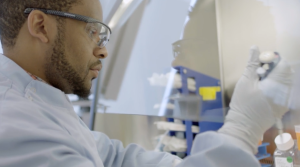In 2019, CCRM launched a new blog to explain products, processes, terms, technologies, techniques and much more related to developing and manufacturing cell and gene therapy products. As a contract development and manufacturing organization (CDMO), CCRM wanted to share its knowledge with the global community.
Fast forward to 2023 and CCRM is retiring the CDMO blog. It will find a new home with OmniaBio Inc., its subsidiary. OmniaBio is a CDMO offering preclinical to commercial-stage manufacturing for cell and gene therapy customers. New content is coming soon. In the meantime, here’s one from the archives (written by CCRM scientists).
How do CAR T cells work to engineer a patient’s immune system to fight cancer?
Conventional cancer treatments (e.g. surgery, chemotherapy/radiation) do not specifically target cancer cells and, as a result, can cause extensive off-target damage, and complications for patients.
In the last several years, ground-breaking research and advancements in genetic engineering have led to the development of a novel treatment strategy, known as immune therapy, that is rapidly emerging as an alternative to conventional cancer treatments. By re-deploying the body’s own immune cells to target and kill cancer cells, immune therapy provides a more targeted method to treat cancer. The most advanced development in cellular immunotherapy for cancer has been bioengineered T cells, modified to express a special surface receptor called a chimeric antigen receptor (CAR). CARs target unique receptors on specific cancer cells, allowing CAR Ts to selectively recognize, bind, and kill cancer cells in vivo by initiating the body’s natural immune response.
CAR Ts have made the most impact in the treatment of leukemias and lymphomas. To date, this has led to the approval of two commercial CAR T cell therapies targeting these indications: Yescarta® (Kite Pharma) and Kymriah® (Novartis). Both therapies are approved for the treatment of B-cell lymphoma, and work by targeting the CD19 surface antigen. CD19-targeted CAR Ts have demonstrated great efficacy in the lab and in the clinic. The CD19 receptor is found on all B-cells and is not specific to cancerous cells. However, patients can survive without B-cells, and therefore the lack of specificity has not hampered the use of CAR Ts in the treatment of B-cell lymphoma. The next challenge is to find ways to use CAR Ts for indications with more complex targets, where specificity is crucial.
Improved targeting of CAR Ts is important because the receptors on most types of cancer cells are also expressed on many healthy cell types, making the identification of a cancer-cell-specific target challenging. Current efforts in the field are focused on developing more sophisticated approaches to define cancer cell targets. For example, some approaches are using multiple antigen targeting strategies, while others are combining CAR Ts with other drugs or biologics, such as checkpoint inhibitors.
Many groups developing the next generation of CAR Ts are focused on engineering new safety mechanisms to prevent the immune system from kicking into overdrive in response to the introduction of CAR Ts. Commonly referred to as a cytokine storm, the severe and potentially life-threatening immune response experienced by some patients treated with CAR Ts is one of the biggest safety concerns associated with this treatment.
Current research aims to engineer tools that will allow for more fine-turned control over modified T-cells in vivo. For instance, bioengineered cells that can be controlled with suicide switches are one approach to this challenge. Effective use of these novel enhancements will aim to address some of the clinical challenges associated with these therapies and allow the power of CAR T to be harnessed to treat a wider array of cancers more safely and effectively.
Despite success in the clinic, the adoption of CAR Ts will face many hurdles due to a high price tag. For example, Kymriah was initially priced at USD$475,000 for a single-dose.
Cost Drivers for CAR T Therapies
- CAR Ts are autologous cell products: each dose is a bespoke product, made using the patient’s own immune cells. To drive down costs and increase accessibility, one approach being pursued by many companies is the use of off-the-self or allogeneic CAR Ts. Several clinical stage companies are aiming to create processes in which CAR Ts could be generated from a single, healthy donor in a scalable system and used to treat many patients.
- Use of viral vectors, most commonly lentiviral vectors (LVV) for genetic modification: LVVs are currently very costly to manufacture and suffer from low product yields. While the field has started investigating non-viral methods of genetic modification, overall process improvements in LVV manufacture will also deliver cost savings. CCRM is well positioned to help developers address this challenge with process development capabilities to improve, scale and streamline LVV manufacturing.
In addition to a streamlined process for upstream LVV production, a major concern for developers of potential CAR T therapies is achieving process consistency. Decades-old bioprocess and biopharma manufacturing practices must be creatively re-imagined to meet the unique challenges emerging in the cell therapy industry. An autologous cell therapy must be manufactured under rigorously standardized and automated conditions not only to mitigate operator error and contamination risk, but also to achieve reproducible and consistent cell therapies between patient batches.
If this type of technical post is of interest to you, be sure to visit the CDMO blog on OmniaBio’s website for more insights into manufacturing for cell and gene therapies.
Stacey Johnson
Latest posts by Stacey Johnson (see all)
- Right Turn: Beyond the ’stache: The science, the progress, the promise - November 26, 2025
- Right Turn: Can Bryan Johnson live forever? Will regenerative medicine help him do so? - October 10, 2025
- Right Turn: #pinksocks, diabetes news and other ramblings - June 24, 2025







Comments